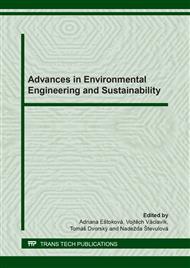[1]
N. Junakova, J. Junak, Sustainable use of reservoir sediment through partial application in building material, Sust. 9 (2017).
DOI: 10.3390/su9050852
Google Scholar
[2]
J. Junak, Utilization of crushed glass waste in concrete samples prepared with coal fly ash, Sol. Sta. Phenom. 244 (2016) 102–107.
DOI: 10.4028/www.scientific.net/ssp.244.102
Google Scholar
[3]
Y. Jiang, T-C. Ling, C. Shi, S-Y. Pan, Characteristics of steel slags and their use in cement and concrete—A review, Resour. Conserv. Recycl. 136 (2018) 187–197.
DOI: 10.1016/j.resconrec.2018.04.023
Google Scholar
[4]
M. Ondova, N. Stevulova, L. Meciarova, The Potential of Higher Share of Fly Ash as Cement Replacement in the Concrete Pavement, Proced. Eng. 65 (2013) 45–50.
DOI: 10.1016/j.proeng.2013.09.009
Google Scholar
[5]
N. Stevulova, J. Junak, Alkali-activated binder based on coal fly ash, Chem. List. 108 (2014) 620–623.
Google Scholar
[6]
V. Vaclavik, T. Dvorsky, V. Simicek, M. Ondova, J. Valicek, M. Kusnerova, L. Gola, Steel slag as a substitute for natural aggregate in the production of concrete, Sol. Sta. Phenom. 244 (2016) 77–87.
Google Scholar
[7]
V. Simicek, V. Vaclavik, T. Kubin, T. Dvorsky, A. Brenek, J. Valicek, M. Kusnerova, M. Harnicarova, L. Gola, Volume changes of cement composite based on steel slag during thermal load, Adv. Struct. Mater. 33 (2017) 245–59.
Google Scholar
[8]
A. Estokova, L. Palascakova, Study of Natural Radioactivity of Slovak Cements, Chem. Eng. Trans. 32 (2013) 1675-1680.
Google Scholar
[9]
M. Porhincak, A. Estokova, Comparative Analysis of Environmental Performance of Building Materials towards Sustainable Construction, Chem. Eng. Trans. 35 (2013) 1291–1296.
Google Scholar
[10]
V. Harbulakova, A. Estokova, N. Stevulova, The investigation of concrete'biodeterioration in sewer pipes, case study, Poll. Per. 5 (2010) 87–95.
Google Scholar
[11]
CSN EN 197-1 Cement - Part 1: Composition, specifications and conformity criteria for common cements.
Google Scholar
[12]
A. Radenovic, J. Malina, T. Sofilic, Characterization of ladle furnace slag from carbon steel production as a potential adsorbent, Adv. Mater. Sci. Eng. (2013).
Google Scholar
[13]
CSN EN 196-1 Methods of testing cement - Part 1: Determination of strength. UNMZ, Prague, (2016).
Google Scholar
[14]
CSN 72 2113 Determination of density of cement. UNMZ, Prague, (1989).
Google Scholar
[15]
CSN EN 196-6 Methods of testing cement - Part 6: Determination of fineness. UNMZ, Prague, (2019).
Google Scholar
[16]
CSN EN 1008 Mixing water for concrete - Specification for sampling, testing and assessing the suitability of water, including water recovered from processes in the concrete industry, as mixing water for concrete. ÚNMZ, Prague, (2003).
DOI: 10.3403/02609198
Google Scholar


